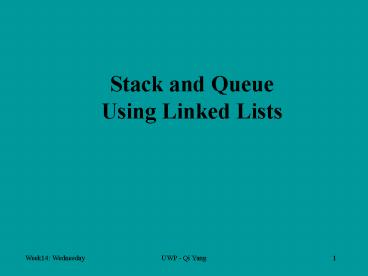Stack and Queue Using Linked Lists - PowerPoint PPT Presentation
1 / 16
Title:
Stack and Queue Using Linked Lists
Description:
The implementation shouldn't matter to the user as long ... treat as a dumb struct, but private to Queue. private class Node. public E info; public Node next; ... – PowerPoint PPT presentation
Number of Views:719
Avg rating:3.0/5.0
Title: Stack and Queue Using Linked Lists
1
Stack and QueueUsing Linked Lists
1
UWP - Qi Yang
2
Stack Upside-Down
8 7 6 5 4 3 2 1 0
top
3
Implementing Stack Using Array
- public class Stack
- private Object items
- private int top 0
- public Stack( int size )
- items new Objectsize
- public void push ( Object obj )
- itemstop obj
- public Object pop()
- return items--top
- . . .
4
Implementing Stack Using Linked List
- The signatures of the methods should stay the
same - The implementation shouldn't matter to the user
as long as it is correct and efficient - Should "top" be the front or back?
- Whats the Big O for pop and push?
- if top is front
- O(1)
- if top is back
- O(n)
- So top should be front!
5
- Top is front
- push insert at front
- top new Node(obj, top)
- pop remove from front
- top top.next
. . .
. . .
top
. . .
top
5
5
6
Implementing Stack Using Linked List
- public class Stack
- Node top
- public Stack()
- top null
- public void push ( Object obj )
- top new Node(obj, top)
- public Object pop()
- Object tmp top.info
- top top.next
- return tmp
- . . .
7
Queue Class
- Make the array circular
front points to where the first element is
rear points to where next element goes
8
public class Queue private Object items
private int front, rear, count ...
public void add ( Object x )
itemsrear x rear (rear 1)
items.length count public
Object remove() Object x
itemsfront front (front 1)
items.length count -- return x
// class Queue
9
Queue Using a Linked List
- Two pointers front and rear
- Both add and remove are O(1).
- Note we make class Node private, so no access
outside the class. - Make the Queue generic it doesnt get the
warnings that the generic array implementation
gave
. . .
front
10
- public class QueueltEgt
- // treat as a dumb struct, but private to
Queue - private class Node
- public E info
- public Node next
- public Node ( E x, Node p )
- info x
- next p
- private Node front rear null
- public boolean isEmpty()
- return front null
- . . .
10
10
11
- add (at rear)
- rear.next new Node ( x, null )
- rear rear.next
- remove (at front)
- tmp front.info
- front front.next
. . .
front
tmp
. . .
front
11
11
12
- public class QueueltEgt
- . . .
- public void add ( E x ) // add at the end
- if ( front null )
- front new Node ( x, null )
- rear front
- else
- rear.next new Node ( x, null )
- rear rear.next
- public E remove() // remove from the front
- if ( front null )
12
12
13
Quiz 5
14
Quiz 6
- Hashing
- Division (remainder)
- Collision
- Linear Probe
- Double hash
- Buckets
- Binary Search
- Linked List
- Add and remove
15
Prog6
- Inheritance
- Polymorphysm
- Class PFigure
- Move
- Other methods
16
Lab 8































